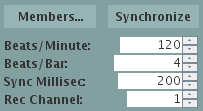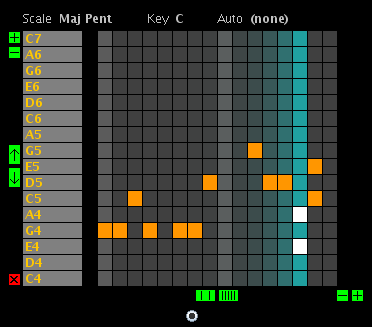
Loopling is launched as a Java Applet in your web browser window. It uses Java's built-in music synthesizer by default, to provide a range of instruments including drum kit, pianos, guitars, strings, brass, electronic sounds, etc. All musical events are handled using the MIDI (Musical Instrument Digital Interface) standard, so you can also hook up an external MIDI keyboard or synthesizer.
Several users can connect together over the Internet as Members of the same Group. Users can listen to
each others' instrumental "loops", play along in perfect sync, and record their jam sessions.
Members and Groups
Input
Instrument Menu
Information Pane
Control Pane
Sequencer
Recording
Chat
Known Bugs
Release Notes
FAQ page

Up to 8 Members can join a Group via a LAN or Internet connection, each bringing their own instrument to the mix. Loopling's sequencers will synchronize with each other for realtime musical collaboration. See Getting Started for troubleshooting connection problems and the FAQ for help with timing problems.
The Group Leader can control tempo and time signature using the Control Pane, and can record members and save the results as a standard MIDI file.
Loopling has built-in text chat, but feel free to use external teleconferencing software to communicate with group members while jamming.
There are 5 sources for musical input:

|
The synthesizer will play the instrument you have selected in the Instrument Menu. The entire GM (General MIDI) instrument set is available: drums, keyboards, strings, brass, woodwinds, etc. How to play multiple instruments. Only one instrument can be played in each Loopling window. However, you can play more than one instrument on a single computer by creating another Loopling member in a different browser window, connected to the same group. In this case you should disable playback on all but one browser window, by clicking the "speaker" icon. Another alternative is to use the recording controls to overdub different instruments. |
The Information Pane displays the member name and the group name (unless the member is the group leader to begin with).
Below the Information Pane is the Control Pane. This displays the active instrument
name and has controls for:
You can also change the number of Sequencers here.
Click the speaker icon to instantly disable playback, killing all sound. However,
be aware that the notes in your sequence will continue to play for other group members.
The Group Leader will see additional controls:

Control Pane


Sequencer

|
The Sequencer uses a graphical representation of a repeating musical pattern. Notes are shown on the vertical axis and time is represented by the blue cursor moving left to right. Click on the grid to enter notes at each point in time and click the red "x" button to clear the sequence pattern. Your pattern will play in an endless "loop". Play in realtime. Rather than use the sequencer grid you can click the note names directly to play in realtime. Furthermore if you click on the radio button below a sequencer you can trigger the corresponding notes by typing on your computer keyboard (ASDFGHJKL;QWERTYUIOP). Depending on your system, however, the delay between playing and hearing the note may be significant. See the FAQ on audio latency. You may also find it necessary to disable key-repeat for your keyboard, using your system's Keyboard control panel setting. |
The sequencer cycle length is one or more musical bars (measures), represented by light gray lines in the sequencer grid. Increase or decrease the number of bars using the "+" and "-" buttons in the lower-right corner. The "spacing" buttons change the duration of each column in the grid (1/8 note, 1/16 note, etc) and hence the number of columns in each bar.
The number of notes in the sequence can be changed with the "+" and "-" buttons at the upper-left corner, and the note range can be moved up and down with the arrow buttons.
The notes depend on the musical Key and Scale, which can be changed by clicking above the sequencer grid. The Chromatic scale includes all the notes on a piano keyboard (12 intervals per octave). But musical results are easier to achieve using one of the Pentatonic or Triad scales. A Blues scale and the most common ethnic scales are also included.
The Auto options will create or change sequencer patterns automatically, each time the sequencer reaches the end of a cycle. (The "x2" options change on alternating sequencer cycles, and are handy for discovering new patterns.) Because of their random or semi-random nature, these work best with musical scales such as the Pentatonic and Triad scales mentioned above.
You can create multiple sequencers from the Control Pane. Only one sequencer is active, but you can put an alternate pattern in another sequencer and switch to it by clicking its radio button.

The group leader has a set of recording controls at the top of the page, and can record all active members using timestamped MIDI events. The results can be saved as a standard General MIDI file and played back through Loopling or other MIDI compatible software. Many popular media players (QuickTime, Windows Media Player, Winamp, etc) can play General MIDI files, though the quality of the audio samples will vary from system to system.
The recording controls consist of File and Edit menus, transport buttons (rewind, fast-forward, record, stop, play), and a grid representing the bars of the song. You can click a bar to set the Record location and drag to highlight multiple bars for Editing.
MIDI file editing. You can further edit the MIDI file using a MIDI editor such as Pascal Naidon's MidiSwing, an excellent freeware Java application which runs on Linux, Windows, Macintosh, etc.
A note about channels. Each instrument is recorded to a different MIDI channel, and each channel is assigned to its own track in the MIDI file. By default the group leader is on channel 1 and other group members are on channels 2-8. Channel 10 is reserved for drum instruments.

At the bottom of the display is a text field for chatting with group members. Type your message and press the Enter key.
Group leader freezes when member quits. This may occur when using Firefox, when the member is
running in another window of the same browser as the group leader (on the same computer), particularly on Linux systems. You may be
able to avoid this by using a different browser, such as Opera.
2009-08-01. v.0.12 Added recording.
2009-05-01. v.0.1 Initial beta release.